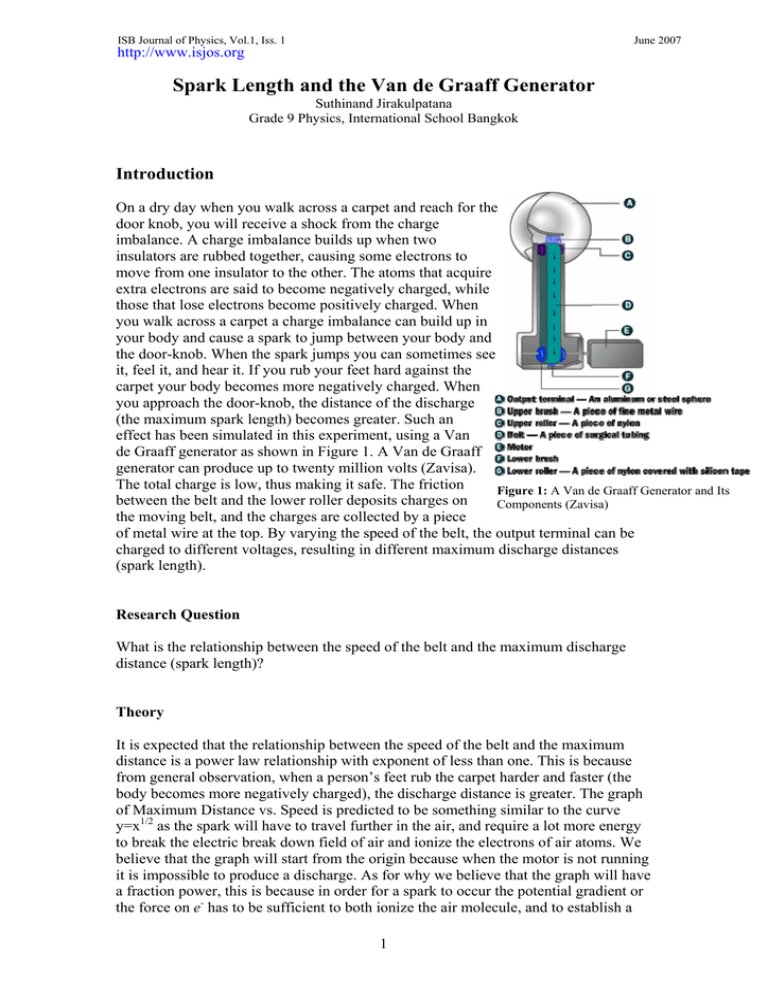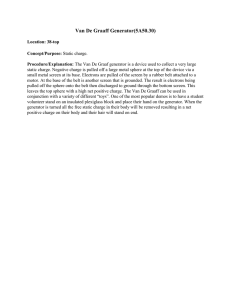Spark Length and the Van de Graaff Generator
advertisement

ISB Journal of Physics, Vol.1, Iss. 1 ISB Journal of Physics June 2007 June 2007 http://www.isjos.org Spark Length and the Van de Graaff Generator Suthinand Jirakulpatana Grade 9 Physics, International School Bangkok Introduction On a dry day when you walk across a carpet and reach for the door knob, you will receive a shock from the charge imbalance. A charge imbalance builds up when two insulators are rubbed together, causing some electrons to move from one insulator to the other. The atoms that acquire extra electrons are said to become negatively charged, while those that lose electrons become positively charged. When you walk across a carpet a charge imbalance can build up in your body and cause a spark to jump between your body and the door-knob. When the spark jumps you can sometimes see it, feel it, and hear it. If you rub your feet hard against the carpet your body becomes more negatively charged. When you approach the door-knob, the distance of the discharge (the maximum spark length) becomes greater. Such an effect has been simulated in this experiment, using a Van de Graaff generator as shown in Figure 1. A Van de Graaff generator can produce up to twenty million volts (Zavisa). The total charge is low, thus making it safe. The friction Figure 1: A Van de Graaff Generator and Its between the belt and the lower roller deposits charges on Components (Zavisa) the moving belt, and the charges are collected by a piece of metal wire at the top. By varying the speed of the belt, the output terminal can be charged to different voltages, resulting in different maximum discharge distances (spark length). Research Question What is the relationship between the speed of the belt and the maximum discharge distance (spark length)? Theory It is expected that the relationship between the speed of the belt and the maximum distance is a power law relationship with exponent of less than one. This is because from general observation, when a person’s feet rub the carpet harder and faster (the body becomes more negatively charged), the discharge distance is greater. The graph of Maximum Distance vs. Speed is predicted to be something similar to the curve y=x1/2 as the spark will have to travel further in the air, and require a lot more energy to break the electric break down field of air and ionize the electrons of air atoms. We believe that the graph will start from the origin because when the motor is not running it is impossible to produce a discharge. As for why we believe that the graph will have a fraction power, this is because in order for a spark to occur the potential gradient or the force on e- has to be sufficient to both ionize the air molecule, and to establish a 1 ISB Journal of Physics June 2007 path for the current to flow through. Thus, to achieve dielectric break down in the air, the electric field must reach 3 × 106 V/m. The relationship between the electric field, the potential difference, and the distance corresponds to the given equation: E = V / d or d=V/E (1) The equation of V or potential difference where k is a constant, Q is the total charge, d is the distance, and R is the radius of the outer terminal which remains constant is: V=k(Q/R) (2) Therefore, if equation 2 is substituted into equation 1: d = ( k (Q / R) ) / E (3) If the electric field (E) is substituted with 3 × 106 V/m (the electric field break down), then this equation will determine the length of the spark. d = ( k (Q / R) ) / ( 3 x 106 V/m ) (4) As a consequence, it is noticed that the relationship between the total charge on the outer terminal, Q, and the spark length, d, is a direct proportional relationship. The relationship between the total charge and the speed of the belt is predicted to be a fractional power law as there is leakage of charges. It is believed that the leakage rate will increase as the speed of the belt increases. Given that the relationship between Q and d is directly proportional, and the relationship between Q and the speed of the belt is a fractional power law, it is expected that the relation between the speed of the belt and d will be that of a fractional power law. Materials and Procedure The apparatus was set up as shown in Figure 2. A black marker pen was used to draw a small dot on the belt of the generator. It was essential that the dot was not too big as the ink increased the conductivity of the belt, interfering with the charging of the Van de Graaff. The speed of the belt was then varied by turning the dial. A video of the Van de Graaff generator and its moving belt was recorded in order to determine the speed of the belt. The generator was left running for 30 seconds before the discharge wand was slowly moved towards the sphere until a spark sound (zap) could be heard. The distance between the sphere and the wand was then measured using a ruler. The wand was moved away, and the generator left to recharge to equilibrium for 30 seconds until the next trial began. Five different belt speeds were tested, with three 3 trials each. 2 Figure 2: The wand was slowly moved towards the sphere until a spark sound (zap) could be heard. ISB Journal of Physics June 2007 Data Collection and Processing Calculations Table 1: The time taken (from the video recording) for a marked black dot to reappear. Time (±0.01) (secs) 0.27 0.57 0.87 1.17 1.47 It took 4 + (excess distance/distance of 1 cycle) cycles for the dot to reappear at the exact same place. The excess distance of the cycle was calculated by setting the scale and measuring the distance. Therefore, the speed of the belt was calculated by using the formula: Speed of the Belt = Number of cycles Time for the dot to reappear very close to the first dot Figure 3: The program Logger Pro was used to calculate the time taken for the belt to move one cycle and the excess distance by setting the scale. In this example, the time taken for the dot to reappear very close to the first dot is 1.47 – 0.27 = 1.20 sec. The number of cycles taken for the first dot to reappear at the place is 4 + (9.0/96.3) = 4.1 ± 0.1 cycles Therefore, the speed of the belt is: 4.1 / 1.20 = 3.3 ± 0.1 cycles per second The distance of 1 cycle is calculated by using Figure 4. Total Distance of 1 cycle = 2 semi circles + 2 vertical = 2 (2.4π / 2) + 2 (45.6) = 96.3 cm Figure 4: The measurements taken on the Van de Graaff generator 3 ISB Journal of Physics Speed of the Belt (±0.1) (cycles per second) 1.6 3.3 5.5 7.5 8.8 June 2007 Maximum Spark Length (±0.1) (cm) 1.7 1.8 2.1 2.5 2.4 2.0 2.7 3.1 2.9 3.5 3.1 3.8 3.9 4.0 3.5 Average Maximum Distance (±0.3) (cm) 1.9 2.3 2.9 3.5 3.8 Table 2: Distance and average distance of the spark discharge when the generator belt moved at different speeds. Figure 5: This is the Maximum Discharge Distance vs. Speed of the Belt Graph, and a ½ power fit. 4 ISB Journal of Physics June 2007 Conclusion and Evaluation From Figure 5, it is clear that our prediction which stated that the relationship between the speed of the belt and the maximum spark length is that of a power law with a fractional exponent is strongly supported, as the power fit has gone through all the uncertainty bars. As shown in Figure 5, a ½ power fit was tried and the curve nicely went within every uncertainty bar. Also as predicted, the fit has gone through the origin because when the belt is not moving (and the sphere is neutral), it is impossible to produce a spark. According to Figure 5, the relationship between Maximum Discharge Distance (D) and the Speed of the Belt (S) is shown in the equation: D =(1.28 ± 0.03cm s) S 0.5 (5) This equation may be applied only for the belt speed range of 1.6 to 8.8 cycles per second, for the same type of Van de Graaff generator, and in a similar environment. The fact that the graph is a curve with a fractional power implies that a long discharge distance requires significantly higher belt speeds. From observing the experiment conducted, some of the charges were being used to ionize the air surrounding the sphere. This could be detected by placing the forearm near the output terminal, and noting that the hairs on it stood on end. Several factors could have contributed to the uncertainties of this research. During class, there were many people present in the room creating a high humidity level. It was noticed that when people started leaving the room, the distance of the discharge became greater. The time required for significant changes in humidity was approximately half an hour. Increased moisture in the air allowed the charge to continuously escape into the air at a higher rate, and created a low-resistance path for the electrons to flow through, thus reducing the charge on the Van de Graaff. An ideal solution would be to conduct this experiment in a humidity controlled atmosphere. Another problem encountered was that the black marker pen used to mark the dot on the belt increased the conductivity of the insulator, and reduced the ability of the belt to convey charges. The source of this error could be eliminated by designing/using a belt which already has a dot printed on it, so that it still acts as an insulator. Works Cited Zavisa, John M. "How Van de Graaff Generators work." Howstuffworks. 28 Aug. 2007 <http://science.howstuffworks.com/vdg3.htm>. 5






